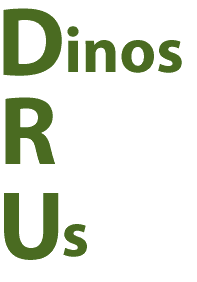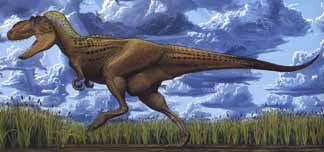|
First we need a basic description of the phenomenon itself. Framing the history of the dinosaur image means starting with its invention in the 1840s and tracing its emergence as a media superstar in global popular culture at the end of the 20th century-all within a bare-bones outline of the story of modern culture from the Enlightenment through the Industrial Revolution to the postmodern era of biocybernetic reproduction.
Although dinosaur fascination is as strong in Japan as it is in the United States, and England and France pioneered the early research in paleontology, the U.S. is a logical focus for such a study. It was the site of the first major "bone rush" during the golden age of dinosaur discovery in the late 19th century. The excavation and display of big fossil bones had been connected to national pride and prestige since the era of Thomas Jefferson, the "mammoth president," who filled a room of the White House with prehistoric bones. And in the late 20th century, the U.S. continued to be the worldís largest producer and exporter of dinosaur images.
When historians of science look at dinosaur images, they are likely to come up with a model of "progressive evolution." The story of dinosaur images is seen as progressing from error to truth, ignorance to understanding. Scientific images, including those of the dinosaur, evolve by steady, gradual improvement toward more and more accurate reflections of the actual thing they represent. On the one hand, more complete knowledge of comparative anatomy and the filling in of the fossil records provide a basis for more accurate descriptions and restorations, while advances in imaging technology produce more realistic, accurate, and vivid representations. The only problem with this story of progressive evolution is that it doesnít fit the facts, either of the history of dinosaur images or of images more generally.
The history of scientific dinosaur images is typically divided into three periods. The "Victorian" or early modern era, from 1840 to 1900, was a period of eclecticism in which dinosaurs are depicted in a variety of shapes reminiscent of reptiles, lizards, dragons, large mammals, birds, fish, and amphibians.
Next comes the period of what Stephen Jay Gould calls "the modern consensus" (1900ñ1960), when dinosaurs take on their "classic" and still-popular images as "swamp-bound monsters of sluggish disposition, plodding with somnolent strides-dimwitted and unresponsive to change" on a slow path to extinction. This period is usually associated with the paintings of Charles Knight-especially those that show dinosaurs as heavily armored leviathans poised for single combat-and with the huge Rudolph Zallinger mural
of "The Age of Reptiles" at the Yale Peabody Museum, showing all varieties of dinosaurs gathered in a single arcadian panorama.
Since the 1960s, we have experienced the "dinosaur renaissance," which has transformed the image of the dinosaur into a lively, intelligent, agile, birdlike, warm-blooded creature that works in groups to solve problems. If the Iguanodon was the marquee attraction of the Victorian dinosaur, and the T-rex and Brontosaurus shared the modern stage (with a supporting cast of Triceratopses and Stegosauruses), our contemporary, "postmodern" dinosaur is exemplified by the Velociraptor, who achieves stardom in Jurassic Park as a "clever girl," a fast-moving, team-playing problem solver who hunts in packs.
Now, one could describe this progression simply as a movement from the errors and ignorance of Victorian fantasy to the scientific accuracy and certainty of our own day. And thereís no doubt that our dinosaur images are now based on much more fossil evidence and drastically improved technologies for comparing anatomical data. But the progression is far from "progressive" in some crucial ways. For one thing, many dinosaurologists regard the modern era of the slow, stupid, reptilian figure as a regression in the evolution of the dinosaur image. Paleontologist Robert Bakker, for instance, sees the period as an oppressive orthodoxy that is now to be overturned by his own "dinosaur heresies" (the title of his 1986 book). Bakker portrays his "dinosaur renaissance" as a revival of Victorian images, particularly those which emphasize the bird-like characteristics: the dinosaur as a giant and very dangerous chicken.
|
|

